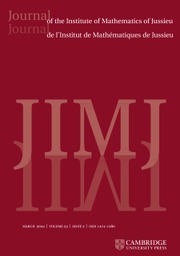No CrossRef data available.
Article contents
FONCTIONS ADDITIVES EN BASE DE CANTOR LE LONG DES NOMBRES PREMIERS
Published online by Cambridge University Press: 06 May 2025
Résumé
Étant donnée une suite  $A = (a_n)_{n\geqslant 0}$ d’entiers naturels tous au moins égaux à 2, on pose
$A = (a_n)_{n\geqslant 0}$ d’entiers naturels tous au moins égaux à 2, on pose  $q_0 = 1$ et, pour tout entier naturel n,
$q_0 = 1$ et, pour tout entier naturel n,  $q_{n+1} = a_n q_n$. Tout nombre entier naturel
$q_{n+1} = a_n q_n$. Tout nombre entier naturel  $n\geqslant 1$ admet une unique représentation dans la base A, dite de Cantor, de la forme
$n\geqslant 1$ admet une unique représentation dans la base A, dite de Cantor, de la forme  $$ \begin{align*} m = \sum_{j\geqslant 0}\varepsilon_j(m)q_j\quad \text{avec} \quad 0\leqslant \varepsilon_j(m) < a_j = \frac{q_{j+1}}{q_j}. \end{align*} $$
$$ \begin{align*} m = \sum_{j\geqslant 0}\varepsilon_j(m)q_j\quad \text{avec} \quad 0\leqslant \varepsilon_j(m) < a_j = \frac{q_{j+1}}{q_j}. \end{align*} $$ $$ \begin{align*} S = \sum_{n \leqslant x}\Lambda(n) f(n) \end{align*} $$
$$ \begin{align*} S = \sum_{n \leqslant x}\Lambda(n) f(n) \end{align*} $$ $\Lambda $ est la fonction de von Mangoldt et f une fonction fortement multiplicative en base A. L’estimation des sommes de type I et II associées repose sur le bon contrôle de transformées de Fourier discrètes de fonctions construites à partir de f par décalage dans la numération en base A. Cette approche pouvant échouer si la suite
$\Lambda $ est la fonction de von Mangoldt et f une fonction fortement multiplicative en base A. L’estimation des sommes de type I et II associées repose sur le bon contrôle de transformées de Fourier discrètes de fonctions construites à partir de f par décalage dans la numération en base A. Cette approche pouvant échouer si la suite  $(a_n)_{n\geqslant 0}$ est trop irrégulière, nous introduisons la notion de base de Cantor tempérée et obtenons dans ce cadre une majoration générale de la somme S.
$(a_n)_{n\geqslant 0}$ est trop irrégulière, nous introduisons la notion de base de Cantor tempérée et obtenons dans ce cadre une majoration générale de la somme S.
Nous étudions plusieurs exemples dans la base  $A = (j+2)_{j\geqslant 0}$, dite factorielle. En particulier, si
$A = (j+2)_{j\geqslant 0}$, dite factorielle. En particulier, si  $s_A$ désigne la fonction somme de chiffres dans cette base et p parcourt la suite des nombres premiers, nous montrons que la suite
$s_A$ désigne la fonction somme de chiffres dans cette base et p parcourt la suite des nombres premiers, nous montrons que la suite  $(s_A(p))_{p\in \mathcal {P}}$ est bien répartie dans les progressions arithmétiques, et que la suite
$(s_A(p))_{p\in \mathcal {P}}$ est bien répartie dans les progressions arithmétiques, et que la suite  $(\alpha s_A(p))_{p\in \mathcal {P}}$ est équirépartie modulo
$(\alpha s_A(p))_{p\in \mathcal {P}}$ est équirépartie modulo  $1$ pour tout nombre irrationnel
$1$ pour tout nombre irrationnel  $\alpha $.
$\alpha $.
Abstract
Let  $A=(a_n)_{n\geqslant 0}$ be a sequence of integers greater than or equal to
$A=(a_n)_{n\geqslant 0}$ be a sequence of integers greater than or equal to  $2$, let
$2$, let  $q_0=1$ and for all
$q_0=1$ and for all  $n\geqslant 0$,
$n\geqslant 0$,  $q_{n+1}=a_n q_n$. Every positive integer n has a unique expansion in the base A, called Cantor base, given by
$q_{n+1}=a_n q_n$. Every positive integer n has a unique expansion in the base A, called Cantor base, given by  $$ \begin{align*} m=\sum_{j\geqslant 0}\varepsilon_j(m)q_j\quad \text{with} \quad 0\leqslant \varepsilon_j(m)< a_j=\frac{q_{j+1}}{q_j}. \end{align*} $$
$$ \begin{align*} m=\sum_{j\geqslant 0}\varepsilon_j(m)q_j\quad \text{with} \quad 0\leqslant \varepsilon_j(m)< a_j=\frac{q_{j+1}}{q_j}. \end{align*} $$ $$ \begin{align*} S=\sum_{n \leqslant x}\Lambda(n) f(n), \end{align*} $$
$$ \begin{align*} S=\sum_{n \leqslant x}\Lambda(n) f(n), \end{align*} $$ $\Lambda $ stands for the von Mangoldt function and f for a strongly multiplicative function in base A. Estimating associated sums of type I and II requires good control on discrete Fourier transforms built from f by shifting the representation in base A. This approach may fail if the sequence
$\Lambda $ stands for the von Mangoldt function and f for a strongly multiplicative function in base A. Estimating associated sums of type I and II requires good control on discrete Fourier transforms built from f by shifting the representation in base A. This approach may fail if the sequence  $(a_n)$ is too irregular. Therefore we introduce the notion of tempered Cantor base and obtain in this setting a general bound on S.
$(a_n)$ is too irregular. Therefore we introduce the notion of tempered Cantor base and obtain in this setting a general bound on S.
We study several examples in the base  $A = (j+2)_{j\geqslant 0}$, also called factorial number system. In particular, if
$A = (j+2)_{j\geqslant 0}$, also called factorial number system. In particular, if  $s_A$ denotes the sum of digits function in this base and p runs along the prime numbers, we prove that the sequence
$s_A$ denotes the sum of digits function in this base and p runs along the prime numbers, we prove that the sequence  $(s_A(p))_{p\in \mathcal {P}}$ is uniformly distributed in residue classes, and, for any irrational number
$(s_A(p))_{p\in \mathcal {P}}$ is uniformly distributed in residue classes, and, for any irrational number  $\alpha $, that the sequence
$\alpha $, that the sequence  $(\alpha s_A(p))_{p\in \mathcal {P}}$ is uniformly distributed modulo
$(\alpha s_A(p))_{p\in \mathcal {P}}$ is uniformly distributed modulo  $1$.
$1$.
MSC classification
Information
- Type
- Research Article
- Information
- Journal of the Institute of Mathematics of Jussieu , Volume 24 , Issue 5 , September 2025 , pp. 1807 - 1865
- Copyright
- © The Author(s), 2025. Published by Cambridge University Press
Footnotes
Author is deceased


